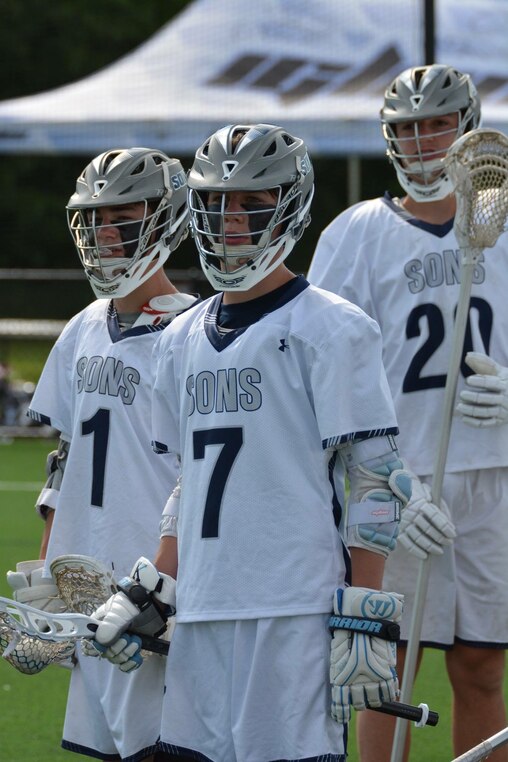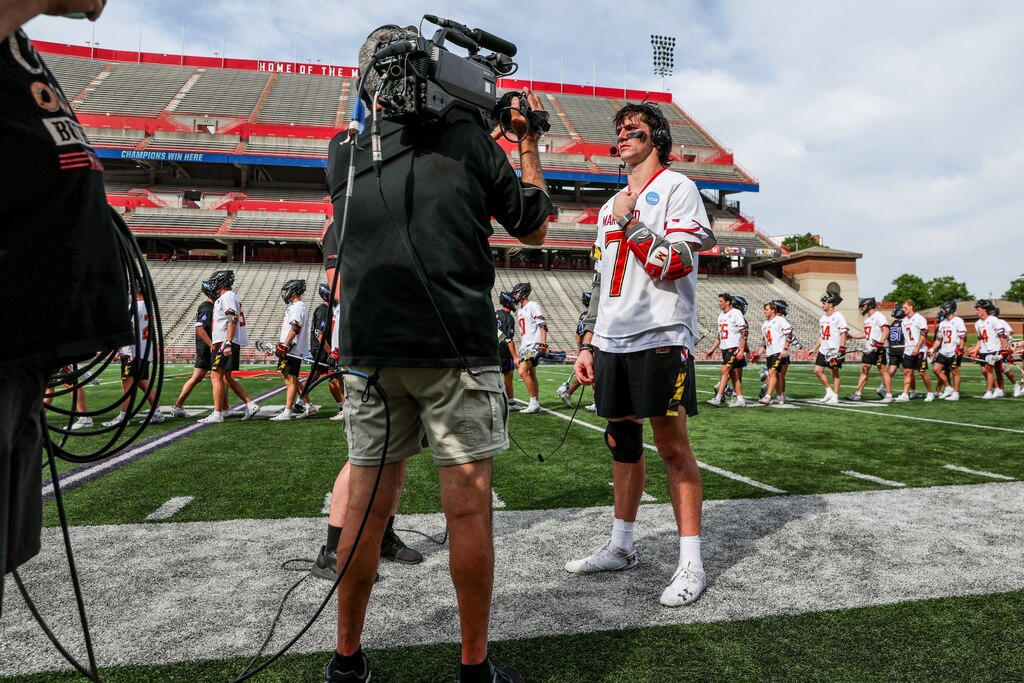Eric Spanos was barely a teenager when Division I coaches started to ask what he could do as a young adult. They would call his club lacrosse coach with urgent, impossible questions — Do you really think he’s going to turn into what you think he can? — and Tad Doyle would tell them, yes, the kid was that good.
But all Doyle could do — all anyone could do, really — was guess and hope for the best. Because Spanos was just a kid, an eighth grader, when he decided to end his college recruitment. He’d never had a job. Never had a girlfriend. Never driven a car. He’d only just recently ditched his braces. But at age 14 Spanos wanted Maryland, and Maryland wanted Spanos. In that bygone era of lacrosse, that was enough.
And so it was that, in February 2017, the Howard County native called Terps coach John Tillman and became what’s believed to be the youngest boys lacrosse player to ever commit.
“I was so young,” Spanos said Thursday, reflecting on the significance of his decision, “I didn’t really even understand it fully at times.”
The Baltimore Banner thanks its sponsors. Become one.
Eight years, three knee surgeries and 72 college goals later, Spanos stands as both a historical marker and a difference maker in the sport. The senior attackman is the leading scorer for a Terps team that, with a win Sunday over Georgetown at Navy-Marine Corps Memorial Stadium, would clinch the program’s 30th Final Four appearance and 11th under Tillman. In a first-round NCAA tournament win Sunday, Spanos scored a career-high six goals as second-seeded Maryland routed Air Force 13-5.
His emergence as an All-America-level talent has been a long time coming. When Spanos’ Terps career ends after next season, his fifth in College Park, he will have been tied to his dream school for nearly a decade, an eternity in a sport transformed by recruiting rules and the transfer portal. There may never be another Eric Spanos, and everyone in Spanos’ orbit seems relieved by that.
Said Tillman: “I’m glad we don’t do that anymore, in terms of how early we recruit.”
But a decade ago that was the “rat race,” said Ty Xanders, a St. Paul’s graduate and analyst for Prep Lacrosse. Xanders remembers being a high school senior in 2009 when a sophomore lacrosse player committed, an unusually early pledge for the sport.
“That was the commitment that really kicked off recruiting,” Xanders said.
The Baltimore Banner thanks its sponsors. Become one.
It wasn’t long before the one-upmanship accelerated. Spanos was in the seventh grade when he heard youth coaches telling him to play like college coaches were watching — because they were. And the earlier that players committed, Xanders said, the bolder college coaches got with their own recruiting timetables.
Top prospects started committing as sophomores, then as freshmen, then as eighth graders. “A broken process,” Xanders called it.
“I was so young. I didn’t really even understand it fully at times.”
Eric Spanos
“It was a wild time,” he said. “I think a lot of people, even myself, look back and just think, ‘What the hell were we doing?’ Because it made lacrosse an outlier from other sports. … Compared to everybody else, we had big egg on our face and were doing everything wrong.”
Xanders was skeptical about the rush to commit. He joked that he would wonder whether recruits were picking a program for its school colors or its actual offerings. And he wondered why college coaches were so keen to recruit players who might’ve owed an apparent talent advantage to a growth spurt.
Spanos’ commitment, Xanders said, sent “major shockwaves across college lacrosse.” Tillman probably never expected to make them. He remembered a young Spanos as a do-it-all talent with a good frame and high character. Another school saw the same qualities. Penn State, Tillman recalled, “put us on the clock.”
The Baltimore Banner thanks its sponsors. Become one.
On his 14th birthday, Spanos, who moved from Maryland to Pennsylvania as a toddler, had visited State College. Malvern Prep, a Catholic school in the Philadelphia suburbs that Spanos attended, was something of a pipeline for Penn State lacrosse. Spanos returned home wondering whether he’d found his next stop.
“This might be it,” he recalled thinking.


But first Spanos had to visit Maryland, his dad’s alma mater. The pull of home was strong. Jason Spanos grew up in Sykesville, and his mom, Jaime, in Reisterstown. Their son had come to idolize Matt Rambo, another Philadelphia-area attackman who in 2017 won the Tewaaraton Award, the sport’s highest individual honor, after leading the Terps to their first national championship in 42 years.
Maryland, Eric Spanos said, has “always been the dream.” After he visited College Park, he called Tillman. He’d fallen in love with everything. He was ready to commit.
“It felt like — I don’t even know how to describe it. Almost like Christmas,” Spanos said. “It was such a gift being able to actually commit to this place and commit to the coaches and all of that good stuff.”
The Baltimore Banner thanks its sponsors. Become one.
Doyle, who’d coached Spanos on his Rising Sons club since he was 10 or 11, said that, in 2017, “everybody was on the fast track to commit as quickly as possible.” The year before, a ballyhooed eighth grader named Brennan O’Neill had committed to Penn State. (O’Neill would later switch his pledge to Duke, where he won the Tewaaraton in 2023.)
But Doyle acknowledged that his own ego might’ve played a role in Spanos’ timetable. His commitment thrust a spotlight not only on Spanos but also on the club, Doyle said, which was becoming one of the region’s best.
“I know, for him, I don’t feel like there was a rush,” Doyle said. “They just wanted Maryland, and whenever that was going to happen, that was the opportunity. He would not have committed somewhere else just to commit. He would’ve waited a year because he knew he would have a place somewhere.”
The commitment, and others like it, reverberated around the sport. Two months later, in April 2017, the NCAA Division I Council voted to adopt a proposal to limit contact between lacrosse coaches and recruits until Sept. 1 of their junior year, effective immediately. Even Spanos was barred from calling and emailing Tillman.
What the rule couldn’t curtail, however, was Spanos’ newfound attention. Some kids, and even a few parents, would stop to congratulate him on his commitment and ask him about his recruiting process.
The Baltimore Banner thanks its sponsors. Become one.
Others were more envious than curious. Spanos remembered playing a Boston-based team not long after he committed. A handful of fathers of the kids on that team watched from the sideline and “were letting me have it pretty good. I didn’t really understand much of the stuff they were saying at the time.”
At one tournament, Doyle recalled, “kids were just trash-talking him the whole time.” Turnovers were met with chirps: “Oh, yeah, you’re really a Maryland commit?” Doyle said. “There was a bull’s-eye on him. … It was almost like people wanted to prove everybody wrong. And he just embraced it. He was like, ‘It just is what it is. It doesn’t change who I am. I’m just going to compete and prove everybody wrong.’ But there was that. I felt bad for him, almost.”

But Spanos’ early commitment proved serendipitous. In the spring of his freshman year at Malvern, Spanos took an awkward step in a junior varsity game against Calvert Hall and fell over. When he looked down at his leg, his kneecap was “on the side of my knee.” His kneecap was dislocated, he said, and “pretty mangled.”
Doctors expected a quick recovery after surgery, but Spanos suffered a second dislocation before he could even start physical therapy for his first. Then came a third dislocation and a third operation. He was sidelined for over a year. When Spanos was cleared to return, he had to relearn how to run. He could barely change directions.
Doyle said Spanos’ parents started to worry whether Maryland would honor his scholarship. His playing time over his freshman and sophomore seasons at Malvern was limited to situational work.
The Baltimore Banner thanks its sponsors. Become one.
“We didn’t know if he’d ever come back from” the injuries, Tillman said. “But we stayed true to him, told him, ‘We’re with you regardless. Just realize it’s going to be pretty competitive when you get here. But we’re with you. We’re not dropping you.’ To me, that’s the price of doing business. Sometimes you’ll commit to a guy, and he’ll get hurt, and the odds are that, when they get here, sometimes they’re going to get hurt. I just feel like that’s part of what happens. And going against that, I just think, leads to bad karma. So we just always honor that stuff.
“And he had a decision to make: ‘Hey, can I get back healthy enough and play at a Big Ten school at that level?’ And we just didn’t know for a while. We just wanted to let it play out and see what happened.”
It wasn’t until the fall of Spanos’ junior year that he felt like his old self again. But he didn’t look like his old self. Spanos had sprouted from a 5-foot-9, 150-pound freshman to a 6-3, 200-pound upperclassman. He continued to grow, continued to improve. As a senior, Spanos was named an Under Armour All-American and rated a five-star recruit by Inside Lacrosse.
“He was one of the most dominant players out there,” Xanders said.
Spanos’ career at Maryland has followed a similar path. He redshirted as a freshman in 2022, scored 18 goals as a second-line midfielder in 2023, had the second-most points for an NCAA runner-up in 2024, and has posted career highs in goals (29) and assists (15) this season.
Reminders of Spanos’ long journey back to prominence are unavoidable. His roommate is senior faceoff specialist Shea Keethler, who didn’t commit to Maryland until March of his senior season, months after the sport’s national signing day. Their unorthodox recruitments are a recurring bit in their close friendship.
Spanos said he was “forever grateful” for Tillman’s offer. He knows how rare his relationship with Maryland is. Two of the other recruits who committed before the NCAA’s early-contact ban, Georgetown midfielder Kade Goldberg and Notre Dame midfielder Tyler Buchner, will play in Sunday’s quarterfinals in Annapolis, too — but neither for the school he initially committed to.
“He was going to Maryland way before he was 13,” Doyle said of Spanos. “They probably all wanted him. It felt like it was just Maryland. That was it. It’s like, ‘Anything else, I didn’t accomplish my goals.’”





Comments
Welcome to The Banner's subscriber-only commenting community. Please review our community guidelines.